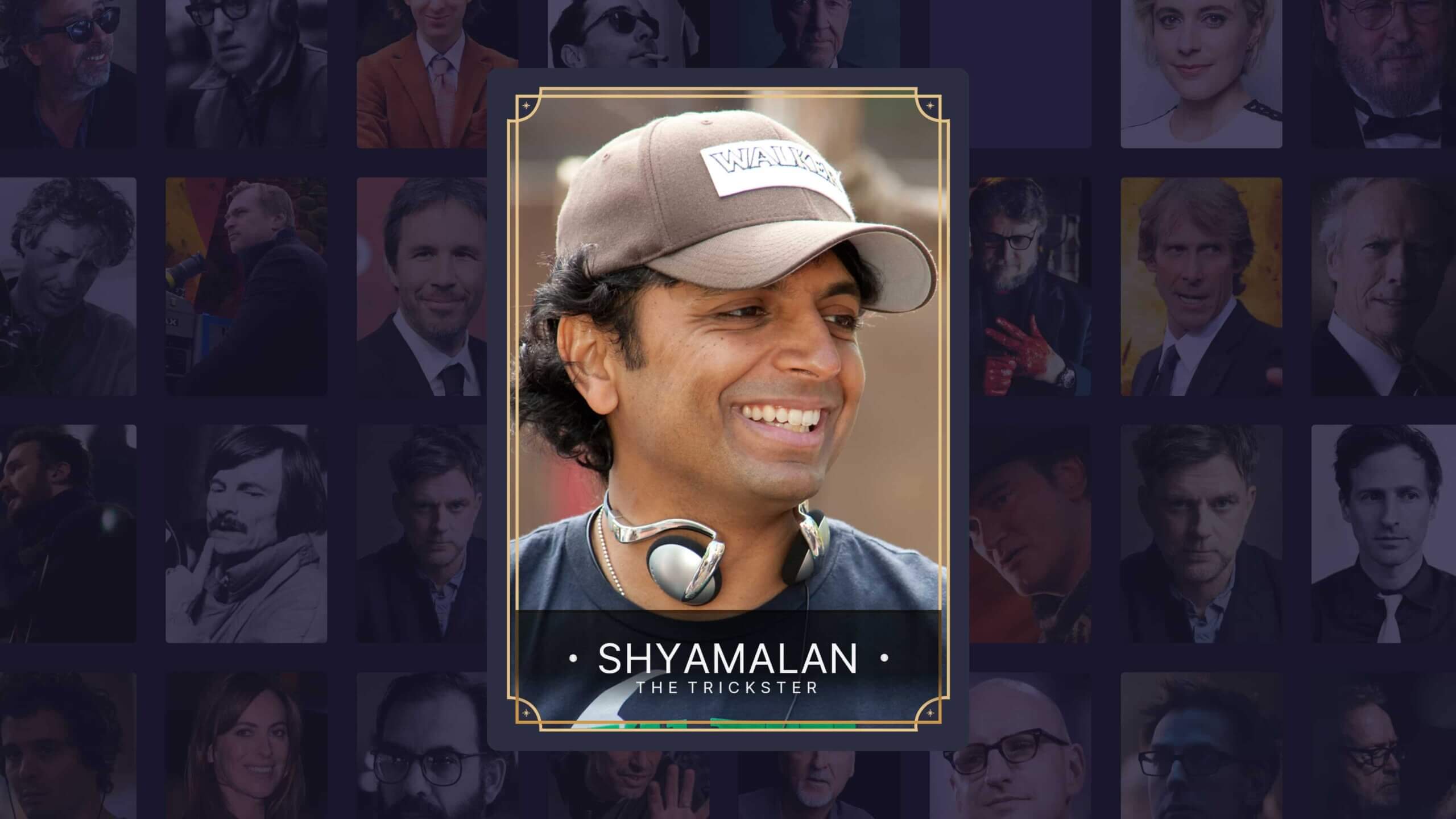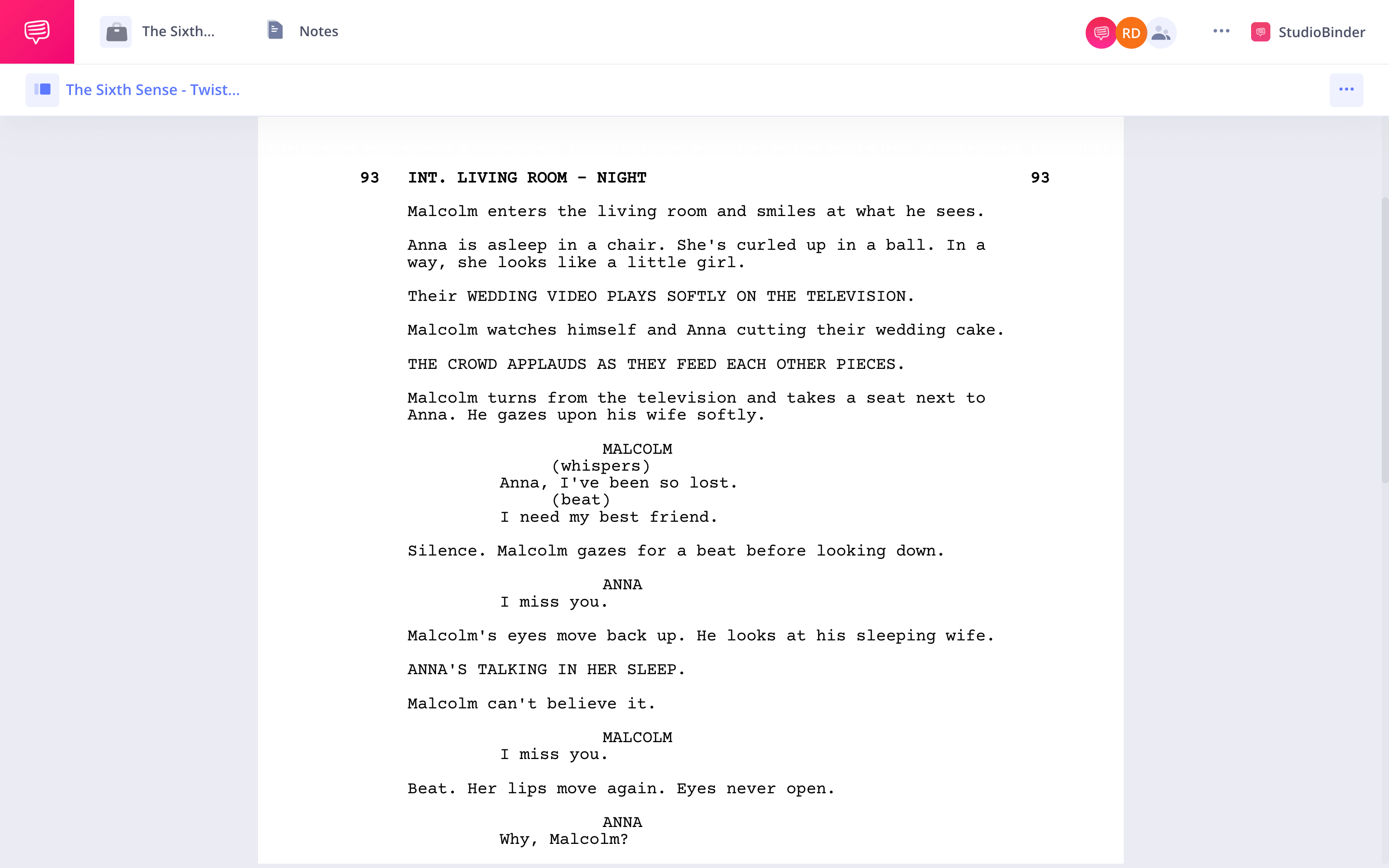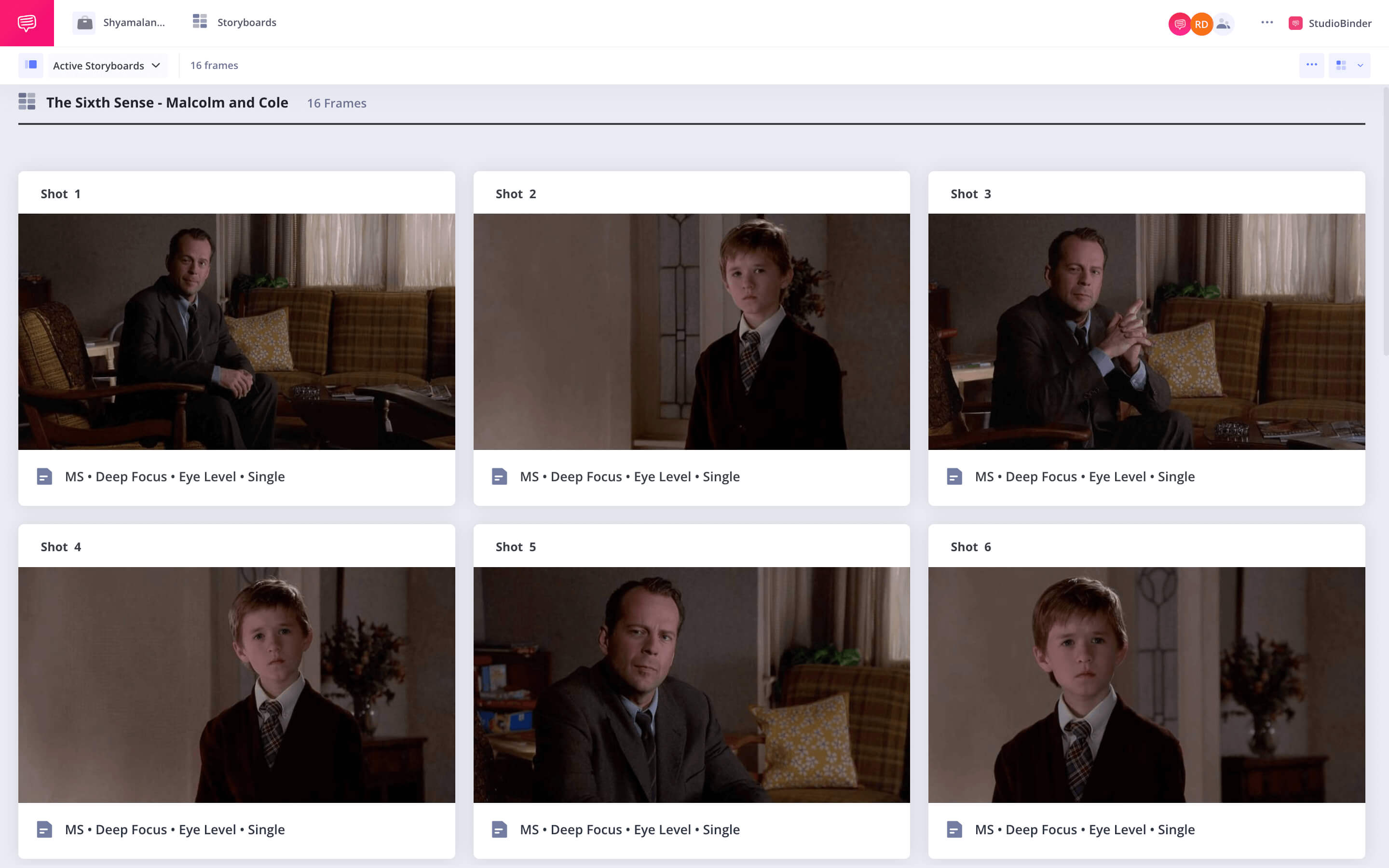Love him or hate him, the M. Night Shyamalan directing style is worth studying. He’s made every kind of movie: universally loved, universally loathed, and a few that will endlessly divide audiences. But before he became a punching bag on the internet, Shyamalan was making exciting and confident masterpieces. If he had never found such success, perhaps his fall from grace would have gone unnoticed. For this post, we’re going to focus on the techniques and strategies that Shyamalan did well. The internet might have irreparably damaged Shyamalan’s reputation but we’re here to rehabilitate it.
meet the man
Who is M. Night Shyamalan?
Manoj Night Shyamalan was born in Puducherry, India and raised in suburban Philadelphia. His connection with Philly is obvious throughout his work.
His first two films came and went, but it was his third feature film that captured the world. The Sixth Sense was a massive hit and brought Shyamalan to the forefront. It made a ton of money and garnered Academy Award nominations, including Best Screenplay, Best Director and Best Picture.
The success of his thriller genre classic The Sixth Sense is directly tied to its shocking twist ending. It's easily one of the best plot twists in film. Many filmmakers have tried to replicate that experience, including Shyamalan himself, but few have gotten anywhere close. But, as of late, you may have noticed that Shyamalan's comeback is strong as ever.
A twist ending is also shocking but the key difference is this: the secret was in the foreshadowing in front of our eyes the whole time.
If you want to read the twist from The Sixth Sense, we’ve uploaded Shyamalan’s script into StudioBinder's screenwriting software. SPOILERS!The Sixth Sense Twist • Read Full Scene
There’s something about The Sixth Sense twist that might not be achievable again. Shyamalan has backed off using so many twist endings, which is for the best. His value as a filmmaker certainly goes beyond his ability to craft the perfect twist ending. Check out our rankings of Shyamalan's best movies.
DEPTH OF ACTION
Multi-plane storytelling
Shyamalan is excellent at storytelling within the frame.
One of his trademarks is using the foreground, middle ground, and background to tell a multi-layered story.
In Lady in the Water, we have some great examples of this strategy. Our first shot is a close-up of Cleveland (Paul Giamatti) trying to kill a bug under the sink. Behind him is the family, terrified and holding weapons.
M. Night Shyamalan films the scene in a single shot lasting one minute and twenty-three seconds. Watch the scene here:
Comedy using foreground and background
This scene is played for comedy, but the advantage of shooting this way is clear. It allows the humor of Cleveland's protracted bug killing to build.
The humor is also supported by the screams of the sisters behind him. We don't need to cut within this scene because we're telling two stories at once — one in the foreground and one in the background.
A few scenes later, we have another single take that uses the foreground and background for suspense instead of comedy.
Cleveland is drawn outside by splashing in the pool after hours. Flashlight in hand, he goes out to investigate.
This shot lasts for one minute and six seconds as we transition between a variety of shot sizes with a single camera move.
The first set-up has Cleveland standing in a wide shot in the foreground, casually scanning the area with his flashlight. He drops a necklace onto a lounge chair and walks away into the background.
The camera then pushes in towards the necklace. Once it is framed in the foreground, the camera rack focuses onto it just as a body leaps from the pool and grabs it.
In the background, Cleveland stands in a wide shot, and the camera continues its move towards him. He steps forward to the edge of the pool, and into a medium shot as he slowly descends into the water.
The length of the shot allows for the suspense to build, but the constant reframing keeps the eye interested without cutting. Cleveland is kept in wide shots, vulnerable and surrounded by the dark, open spaces around him. Then we finally push in closer as he reluctantly enters the pool, focused on his panic.
By accessing the multiple planes in a three-dimensional space, you can tell multiple stories in a single shot. This also allows you to shoot longer takes and let elements like comedy or suspense build.
This is what economic storytelling looks like.
PHYSICAL AND EMOTIONAL DISTANCE
Framing and camera movement
In film language, a close-up brings us physically and emotionally close to a character. The inverse is also true: the further we are away from them, the less connected we are.
In The Sixth Sense, Shyamalan uses these concepts in a scene all about connection and disconnection.
Malcolm Crowe (Bruce Willis) is a therapist trying to break through with his new patient, Cole. He asks him to play a guessing game: with every right answer, Cole must step closer. Every wrong answer means Cole steps further away.
The game will bring these two characters physically closer. Adults watching this scene will immediately identify Crowe's strategy.
But how does Shyamalan use simple film language to push this idea even further? We’ve created a storyboard using StudioBinder's storyboard creator so you can see this progression and digression.
M. Night Shyamalan films character dynamics • See the entire storyboard
When the scene begins, Cole is shot in wide and medium-wide shots. Malcolm gets the first three guesses correct, and Cole takes three steps forward. With each new step, a new frame size is established.
This process brings Cole from a wide shot to a medium close-up. We get a similar progression and increase in shot size for Malcolm. He transitions between a medium-wide and a medium close-up.
But then Malcolm misses the next four guesses in a row, and Cole returns to where he started.
The shot sizes don't merely get smaller, Shyamalan also adds a subtle camera dolly move to the mix. Every time Cole takes a step back, we push the camera away from Malcolm on his reaction.
The process of losing his ground with Cole is dramatically stronger for Malcolm. He assumed he'd be able to win the game so, when he loses, we feel the loss through this addition of camera movement.
The dramatic core is what makes The Sixth Sense one of M. Night Shyamalan’s best movies.
If you're interested in learning more about camera movement, StudioBinder provides an entirely free masterclass series on filmmaking techniques. Check out Episode 4 on Directing the Camera.
m night shyamalan builds personality
Thematic set design
Split is about a character named Kevin Wendell Crumb, and the 23 other personalities living in his head. James McAvoy gives a show-stopping performance as Crumb.
When he is on-screen, you cannot take your eyes off him.
If you do, take a look around the subterranean complex where he keeps his victims. What do we see and how do those spaces support his character development? When Kasey, Claire, and Marcia are abducted, they are kept in a very odd room. It might not seem strange at first glance but take another look.
Each wall is finished with a different material.
The back and side wall is a stone and cement facade. The opposite side wall and ceiling are smooth, unfinished drywall. The bathroom is pristine white porcelain. And the front wall is wooden planks.
The design of this room with an array of juxtaposed materials is an ingenious way to communicate character.
As we mentioned, Crumb is a mixed bag of personas. He switches from a lisping 9-year-old to a proper British lady, to an East Coast macho man.
A breakdown of every one of Crumb's personalities
If you were asked to design a room that represents this character, what would you come up with?
We don't need 24 different elements on the walls to represent each character. That would draw attention to itself. The design we get in the film is simpler, cleaner, and more subtle.
COLORS HEROES AND VILLAINS
Associative colors
A "realistic" superhero movie sounds like an oxymoron. But Shyamalan set out to capture that very idea. Unbreakable is a drama with a superhero sheen on top. The characters are grounded, and the family drama at the core is never ignored.
So, how does one present a superhero movie for the real world? There are no special effects-driven action set pieces. There's only one real fight scene, and it is downplayed to the bare minimum.
Color is a staple of comic books, primarily when those colors are associated with heroes and villains. Imagine how much less iconic Superman would be with the bright red and blue of his costume.
In Unbreakable, colors associated with our hero and villain are subtle to the point of invisibility.
David Dunn is green. From the lockers at his job and his security guard uniform. His rain poncho, which will act as his iconic costume, is a very dark green.
Elijah Price is purple. Unlike David's muted color association, the antagonist's color is much more pronounced. His costumes, the wrapping paper on his gift, and even the stationary he uses to communicate with David is a bold, sharp purple.
Green and purple aren't precisely opposites on the color wheel, but it's close enough. From color alone, we understand these men to be rivals. And dueling colors are often associated with conflict, whether internal or external.
Check out our collection of images from Unbreakable that showcase how color is associated with the characters.
Stylized color is also used when David begins to explore his powers. When he touches someone, we jump to a flashback when they've done some terrible deed. In these sequences, all color is desaturated to near-black & white except what those characters are wearing.
Visually, this extreme color design shows us an abstract view through David's point of view. We understand that what we're seeing is perceived reality, not necessarily the truth. This "power" is as close as we come to a comic book.
All M. Night Shyamalan films use color in thoughtful and dramatic ways. When designing your next project, think about what layers of depth color can add to the characters, themes, and story.
shyamalan does action as ballet
Single-take action
M. Night Shyamalan films don't shy away from long takes. Working in suspense as he does, a long take is almost necessary.
When you can choreograph a shot using camera movement, and interesting blocking, editing becomes less necessary. Let's look at The Last Airbender as further evidence of Shyamalan's skills without the aid of traditional editing.
We're going to look at one specific shot early in the film. It is the first real action set piece and you can watch it below.
Single-Take Action
The shot lasts for a whopping one minute and forty-eight seconds. There is a 2-second cutaway near the beginning, but, really, it's a single-shot action scene.
That's a long time for any shot, let alone during an action scene.
The action is staged for simplicity, and this allows the camera to be more active. Because there are so many visual effects in the scene, the single take allows "breathing room" for the eye.
We keep our scene geography consistent, and each action gets its own moment. There's also something graceful about a well-choreographed fight like this. The uninterrupted image allows the action to more like a dance than a fight.
Another benefit of shooting a scene like this with one shot is the sense of teamwork. Aang, Katara, and Sokka are just beginning their journey together. When we see them in the same frame, working together, that bond starts to be established.
Action scenes don’t typically play a large part in M. Night Shyamalan films but perhaps examples like this suggest they could be.
A single-take action scene is a bravura moment for any filmmaker.
And, when done well, it can add more to the characters that would be lost if it were edited traditionally.
Here’s a challenge: Choreograph a single-take action scene that also develops the character relationships.
ACTION VS PRESENTATION
Single-take suspense
There are many suspenseful moments in Signs. Graham (Mel Gibson) investigated the cornfields at night. In the basement, when the lights go out. Or Graham's close encounter in the kitchen with a butcher knife.
But there is one scene near the end that is also suspenseful. It is the moment the family emerges from the basement, believing the crisis to be over. After Merrill (Joaquin Phoenix) confirms it's safe to come up, Graham carries Morgan (Rory Culkin) to the couch.
Then Bo (Abigail Breslin) demonstrates the dancing people on the TV. Graham goes to bring the TV into the living room, and we end the shot with a close-up reflection of an alien behind him.
Watch it here. SPOILER ALERT!
M. Night Shyamalan directing suspense masterclass
All this happens in a single take lasting one minute and twenty seconds.
The suspense in this scene comes from the contrast between action and editing. The characters are finally able to relax after their harrowing ordeal and Bo's dancing brings much-needed levity to the moment.
Everything is going to be OK.
Except the long take is dragging these moments out and we don't know why. Something's not right, even if the characters believe otherwise. We understand, even on a subliminal level that this family's nightmare isn't quite over.
And when the shot ends with the alien standing behind Graham, our suspicions are confirmed.
The lesson here is that a long take can be used for suspense, even when the characters don't realize it. This contrast between the actions on screen and their protracted presentation creates uncertainty.
There is no music to indicate suspense, and the lighting is a little dim but even. The only thing suggesting dread is the lack of editing.
Next time you have a scene that seems safe but leads up to another tense moment, consider a long take. It will prime the audience, and allow for the jump scare reveal to be subliminally predestined.
If you want to learn trademarks of some other directors, check out our various auteur directors posts.
Auteur Theory Made Practical
Explore directing techniques used by the greats
Learn the styles of these iconic auteur directors. Explore directing tips you can immediately put into action on your next project.
Explore More Auteur Directors
aural storytelling
Subjective sound design
Sound is a great way to get inside a character's head. Subjective sound design can be even more effective than a subjective camera.
The purpose of a diegetic sound design is to help the audience identify with the character. To see what they see or hear what they hear, even for a brief moment, we can engage with them on a whole new level.
In The Village, Shyamalan uses subjective sound design to get us in the head of our lead character, Ivy.
She is mostly blind, only able to see vague shapes and colors.
For Ivy, and every other visually-impaired person, hearing ability increases. In the film, there are a few instances when Ivy hears something that the other characters do not. At her sister's wedding, she hears the crying of the young boys much sooner than anyone else.
Our cue for this ability is a shift in the sound design. The external sounds of the room, the music, dancing, and laughing are brought down in the mix. At the same time, we hear a new sound: a harmonic hum like a large resonating bell.
This subjective sound design is also a great way to build suspense. During Ivy's solo trek to the towns for medicine, she is stalked by one of the mythical creatures. The scene begins after Ivy has broken her walking stick. She discovers the break and snaps it the rest of the way in half. Then, a matching snap comes from somewhere around her.
The sound echoes, and we once again enter her soundscape. The harmonic bell begins as Ivy turns around towards the sound. We listen more intently, just like Ivy, straining to hear everything we can.
As Ivy runs away, she has no choice but to run through a small thicket of young trees. Each limb thwacks her across her arms, and we hear her pain just as much as we see it. Her breathing is also loud in the mix.
This shot is from a low angle, and we basically see nothing, just like Ivy. Our lack of vision and heightened hearing puts us right there with her. And it engenders suspense based on audio rather than the visuals.
MUSIC REPRESENTING CHARACTER
Music tied to character
In Shyamalan's Unbreakable trilogy, the three main characters are closely associated with color.
Green, purple, and yellow become visual motifs for those characters.
But Shyamalan also uses music to represent and inform his characters. In particular, Kevin Wendell Crumb is given a fragmented and expressive musical motif. The abstract quality of the music is directly tied to his multiple personalities.
M. Night Shyamalan films tend to have striking opening credit sequences where music sets the mood for the film. Glass is no different.
In the opening credits to one the best sequels out there, we hear a ticking rhythm punctuated with jagged, piercing violin scratches. It is erratic and panicked, just like what it must be like in Crumb's fractured mind. The Beast, for example, is given a guttural and primal musical theme.
Listen to the entire soundtrack here:
Character themes in music
There is a rich tradition of matching monsters with musical motifs. The Exorcist, Halloween, or Jaws utilize suspenseful musical themes so the viewer can instantly recall the image and the threat of those monsters.
The Beast is given a similar treatment with a slight twist. We hear many low-end string attacks which sound more like a growling beast than anything resembling music.
The line between music and vocalization is blurred.
We can't be 100% sure that what we're hearing is a down-tuned double bass or the growl of The Beast. Either way, it is an incredible sound that adds weight to McAvoy's stellar performance.
When considering the soundtrack to your next film, is there a way to blur the lines between music and character? Keep the audience guessing, and it will activate their imaginations. It will keep them engaged, curious, and nervous.
Related Posts
UP NEXT
Shyamalan's movies ranked
We've gone through the many aspects of M. Night Shyamalan's directing style but how do his films stack up overall? Let's take a trip through his filmography and rank each of his films and their overall success. From cringe-worthy flops to his undeniable masterpieces, rarely has there been a filmmaker which such highs and lows.
Up Next: Best Shyamalan movies →
Showcase your vision with elegant shot lists and storyboards.
Create robust and customizable shot lists. Upload images to make storyboards and slideshows.



